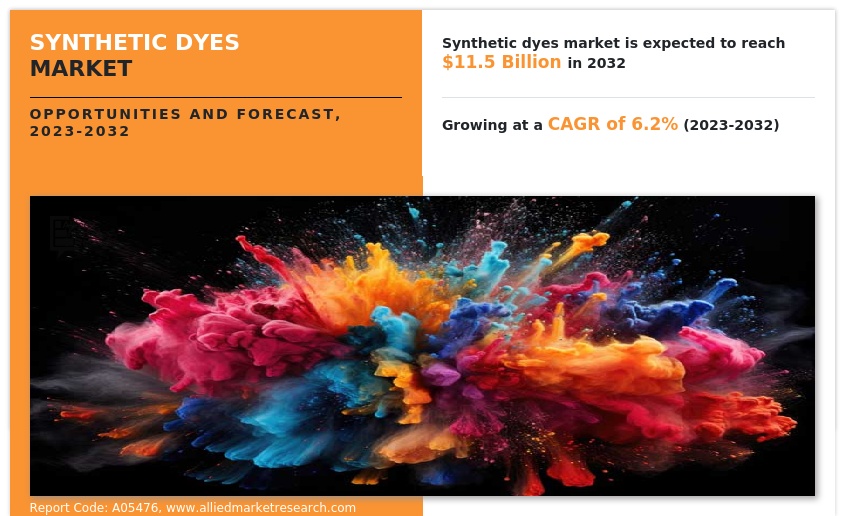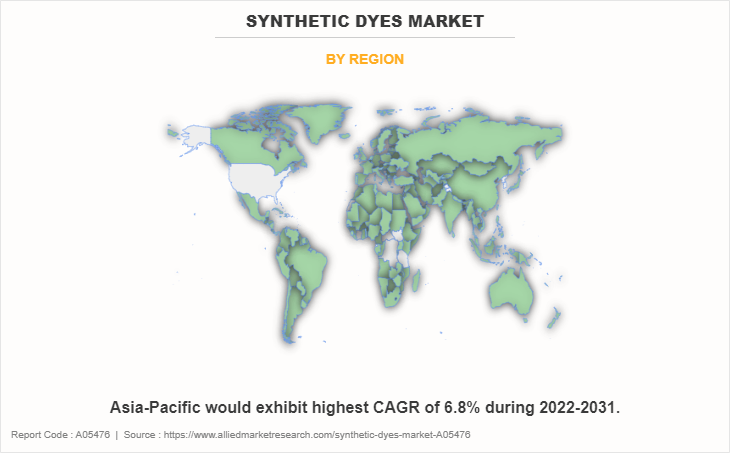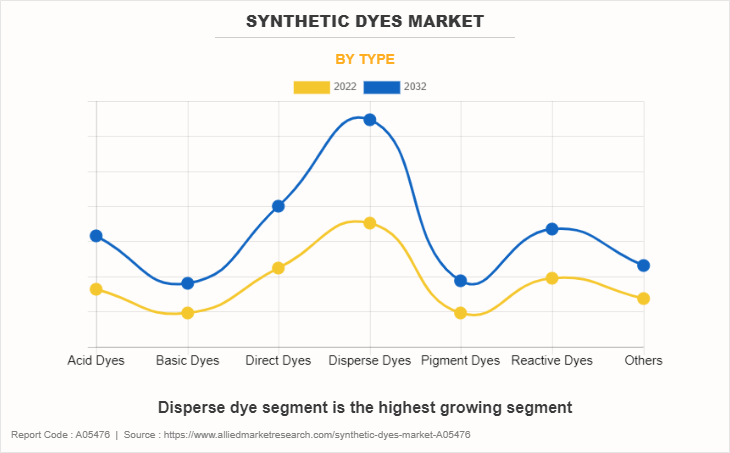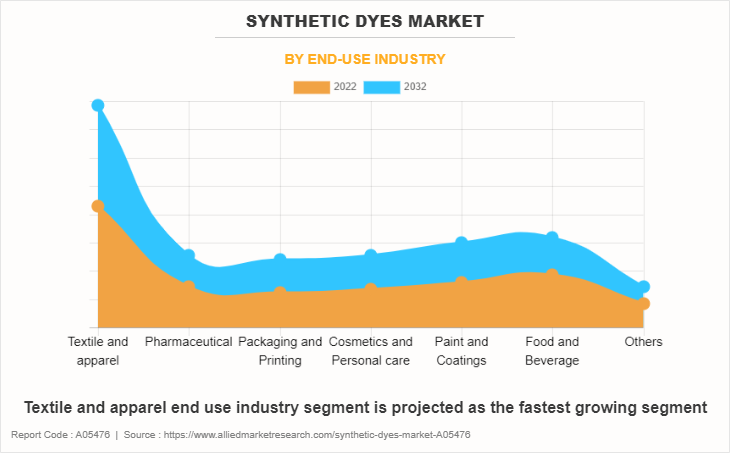Synthetic Dyes Market Research, 2032
The global synthetic dyes market was valued at $6.3 billion in 2022, and is projected to reach $11.5 billion by 2032, growing at a CAGR of 6.2% from 2023 to 2032.
Report Key Highlighters:
- The report outlines the current synthetic dyes market trends and future scenario of the market from 2022 to 2032 to understand the prevailing opportunities and potential investment pockets.
- The global synthetic dyes market has been analyzed in terms of value ($Million) and volume (Kilotons). The analysis in the report is provided on the basis of type, end use industry, 4 major regions, and more than 15 countries.
- The synthetic dyes market is consolidated in nature with few players such as DyStar Singapore Pte. Ltd, Huntsman International LLC, Venator Materials PLC., Kronos Worldwide Inc., BASF SE, Archroma Management AG & Co. KGaA, The Chemours Company, Organic Dyes and Pigments., and Big Sunshine International., which hold significant share of the market.
- The report provides strategy planning and industry dynamics to enhance decision making for existing market players and new entrants entering the synthetic dyes industry.
- Countries such as China, U.S., India, Germany, and Brazil hold a significant share in the global synthetic dyes market.

Synthetic dye is a chemical compound that is used to impart color to various materials, such as textiles, plastics, and paper. They are created through chemical synthesis, as opposed to natural dyes, which are derived from plant, animal, or mineral sources. Synthetic dyes offer several advantages, including a wide range of vibrant colors, colorfastness, and the ability to be produced in large quantities.
The textile industry is one of the largest consumers of synthetic dyes. With rise in global population growing and increase in demand for textiles & clothing, the need for synthetic dyes in this industry has become strong. Synthetic dyes are used in the production of automotive interior materials, such as seats and carpets. As the automotive industry continues to grow, so is the demand for dyes in this sector.
However, the production and disposal of synthetic dyes have a significant environmental impact. Many dye manufacturing processes generate hazardous waste and pollutants, which contaminate water and soil. Some synthetic dyes are non-biodegradable and persist in the environment for a long time. Some synthetic dyes contain toxic chemicals or heavy metals, posing health risks to workers in the dye industry and potentially to consumers when dyed products come into contact with the skin. Regulations and safety standards are in place to mitigate these risks, however, concerns still exist.
On the contrary, regulatory requirements regarding the use of dyes in various end-use industries have evolved, leading to the development and adoption of dyes that meet updated safety and environmental standards. The globalization of trade and manufacturing contributes to the expansion of the synthetic dyes market, as dyes are produced and used in various regions across the globe.
The synthetic dyes market is segmented on the basis of type, end-use industry, and region. On the basis of type, the market is categorized into acid dyes, basic dyes, direct dyes, disperse dyes, pigment dyes, reactive dyes, and others. On the basis of end use industry, it is divided into textile & apparel, pharmaceutical, packaging & printing, cosmetics & personal care, paint & coatings, and food & beverages, and others. Region-wise, the market is studied across North America, Europe, Asia-Pacific, and LAMEA.

Synthetic Dyes Market By Region
The Asia-Pacific Synthetic dyes market size is projected to grow at the highest CAGR of 6.8% during the forecast period and accounted for 41% of Synthetic dyes market share in 2022. The synthetic dyes used in the production of these products experience growth due to international demand. India's economic growth has led to increased consumer spending, which can drive the demand for dyed products, including textiles and clothing.
South Korea has a well-developed chemical industry, and research and development efforts in this sector lead to advancements in dye technology. Synthetic dyes are used in various art and craft projects in Australia, including fabric dyeing, painting, and creative end use industries. These factors are anticipated to boost the Asia-Pacific synthetic dyes industry during the forecast period.

Synthetic Dyes Market By Type
The disperse dyes segment dominated the global market in 2022, and is anticipated to grow at a CAGR of 6.3% during the forecast period. Disperse dyes are known for their excellent color fastness, which means the colors resist fading when exposed to light, washing, and environmental factors. This durability is highly desirable, particularly in outdoor and sportswear markets.
Disperse dyes are compatible with digital printing processes, allowing for precision and detail in custom designs. The growing trend of digital textile printing has increased the demand for disperse dyes. These factors together drive the synthetic dyes market growth during the forecast period; thus, offering the most lucrative opportunities for the disperse dyes segment.

Synthetic Dyes Market By End-Use Indusrty
In 2022, the textile and apparel segment was the largest revenue generator, and is anticipated to grow at a CAGR of 5.9% during the forecast period. Synthetic dyes are often designed to meet regulatory requirements related to health and safety, ensuring that textiles and apparel produced with these dyes are safe for consumers. In the apparel industry, customization and branding are vital for differentiating products and creating unique designs.
Synthetic dyes provide the color flexibility needed to achieve specific branding and design goals. Some synthetic dyes are engineered to resist microbial growth, making them suitable for applications in textiles where hygiene and antimicrobial properties are essential, such as sportswear, medical textiles, and uniforms.
The global Synthetic dyes market profiles leading players that include DyStar Singapore Pte. Ltd, Huntsman International LLC, Venator Materials PLC., Kronos Worldwide Inc., BASF SE, Archroma Management AG & Co. KGaA, The Chemours Company, Organic Dyes and Pigments., and Big Sunshine International. The global synthetic dyes market report provides in-depth competitive analysis as well as profiles of these major players.
Key Benefits For Stakeholders
- This report provides a quantitative analysis of the market segments, current trends, estimations, and dynamics of the synthetic dyes market analysis from 2022 to 2032 to identify the prevailing synthetic dyes market opportunities.
- The market research is offered along with information related to key drivers, restraints, and opportunities.
- Porter's five forces analysis highlights the potency of buyers and suppliers to enable stakeholders make profit-oriented business decisions and strengthen their supplier-buyer network.
- In-depth analysis of the synthetic dyes market segmentation assists to determine the prevailing market opportunities.
- Major countries in each region are mapped according to their revenue contribution to the global market.
- Market player positioning facilitates benchmarking and provides a clear understanding of the present position of the market players.
- The report includes the analysis of the regional as well as global synthetic dyes market trends, key players, market segments, application areas, and market growth strategies.
Synthetic Dyes Market Report Highlights
| Aspects | Details |
| Market Size By 2032 | USD 11.5 billion |
| Growth Rate | CAGR of 6.2% |
| Forecast period | 2022 - 2032 |
| Report Pages | 450 |
| By Type |
|
| By END-USE INDUSTRY |
|
| By Region |
|
| Key Market Players | BASF SE, Venator Materials PLC,, DyStar Singapore Pte Ltd, Archroma, The Chemours Company, Organic Dyes and Pigments., Sunshine International Co., Ltd., Kronos Worldwide, Inc., Huntsman International LLC |
Analyst Review
According to CXOs of leading companies, the global Synthetic dyes market is expected to exhibit high growth potential. The globalization of trade and manufacturing contributes to the expansion of the synthetic dyes market, as dyes are produced and used in various regions worldwide. As environmental concerns grow, there is a demand for more sustainable dyeing processes and eco-friendly dyes. Manufacturers that offer environmentally responsible dyeing solutions is expected to benefit from this trend. Furthermore, advancements in digital printing technologies have expanded the use of synthetic dyes in industries such as textiles and graphics. Digital printing allows for precise color matching and customization, driving the demand for compatible dyes. Growth in industries that use technical textiles, such as healthcare, construction, and industrial end use industries, leads to increased demand for dyes designed for these specialized materials. CXOs further added that sustained economic growth and development of the textile sector have increased the popularity of synthetic dyes.
Synthetic dyes are chemical compounds that are used to impart color to various materials, such as textiles, plastics, paper, and more. They are created through chemical synthesis, as opposed to natural dyes, which are derived from plant, animal, or mineral sources. Synthetic dyes offer several advantages, including a wide range of vibrant colors, colorfastness, and the ability to be produced in large quantities.
Textile and apparel is the leading application of synthetic dyes market.
The synthetic dyes market is segmented on the basis of type, end use industry, and region. By type, it is categorized into acid dyes, basic dyes, direct dyes, disperse dyes, pigment dyes, reactive dyes, and others. By end-use industry, it is segregated into textile and apparel, pharmaceutical, packaging and printing , cosmetics and personal care, paint and coatings, food and beverage, and others. Region-wise, the market is studied across North America, Europe, Asia-Pacific, and LAMEA
DyStar Singapore Pte. Ltd, Huntsman International LLC, Venator Materials PLC., Kronos Worldwide Inc., BASF SE, Archroma Management AG & Co. KGaA, The Chemours Company, Organic Dyes and Pigments., and Big Sunshine International
Digital textile printing has gained momentum, and this technology requires specific types of synthetic dyes. The trend toward customization and on-demand printing has driven the need for dyes suitable for digital printing processes.
Asia-Pacific is the largest regional market for synthetic dyes.
The global synthetic dyes market was valued at $6.3 billion in 2022, and is projected to reach $11.5 billion by 2032, growing at a CAGR of 6.2% from 2023 to 2032
Loading Table Of Content...
Loading Research Methodology...



